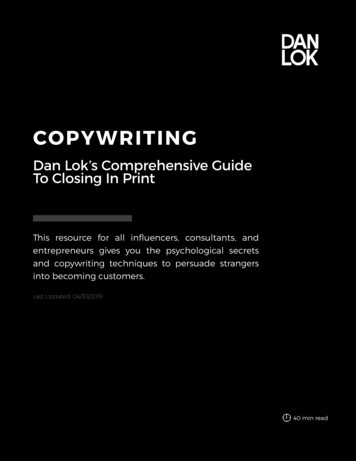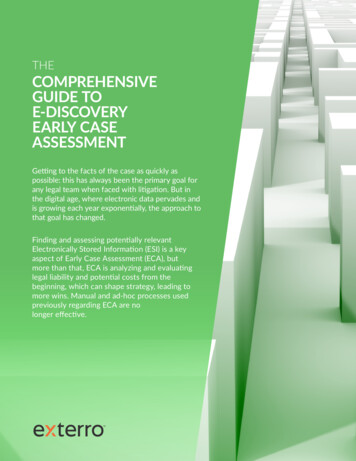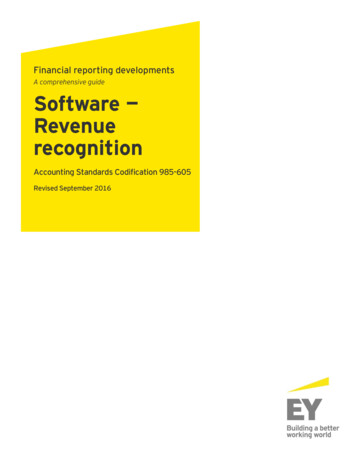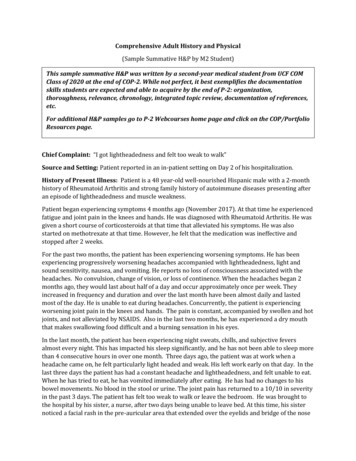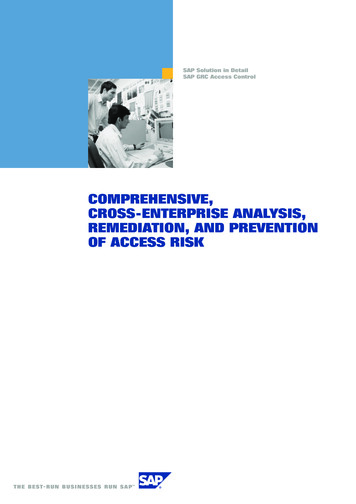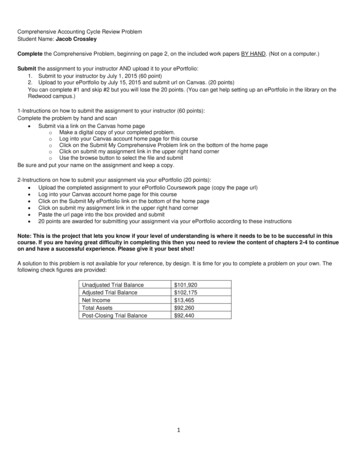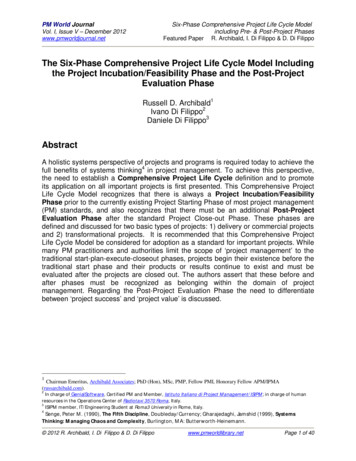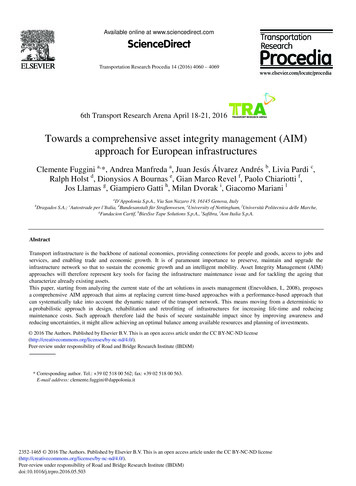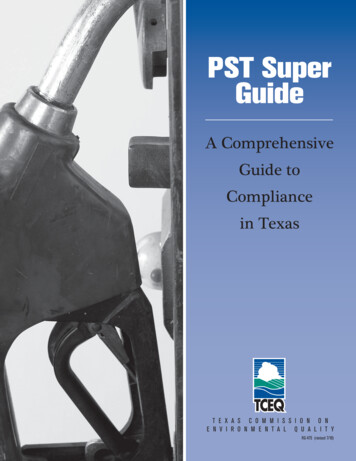
Transcription
PST SuperGuideA ComprehensiveGuide toCompliancein TexasT E X A S C O M M I S S I O N O NE N V I R O N M E N T A L Q U A L I T YRG-475 (revised 7/10)
PST SuperGuideA ComprehensiveGuide toCompliancein TexasT E X A S C O M M I S S I O N O NE N V I R O N M E N T A L Q U A L I T YRG-475 (revised 7/10)
ContentsRG-475a Buying or Selling Property with Underground Storage TanksRG-475b Installing a New or Replacement Underground Storage TankRG-475c Licensed Underground Storage Tank ContractorsRG-475d Petroleum Storage Tank Registration and Self-CertificationRG-475e Petroleum Storage Tank Spill and Overfill Prevention 60-Day Spill-Container InspectionRG-475fProtecting Petroleum Storage Tanks against Corrosion 60-Day Record of Impressed Current Cathodic ProtectionRG-475g Petroleum Storage Tank Release Detection and Inventory Control Monthly Record of Vapor-Well Monitoring Monthly Record of Groundwater-Well Monitoring Monthly Record of Interstitial-Sensor Monitoring Monthly Record of Secondary-Containment-Well Monitoring Weekly Record of Manual Tank GaugingRG-475h Suspected Releases from Petroleum Storage TanksRG-475iFinancial Assurance for Petroleum Storage TanksRG-475jGasoline Stage I and II Vapor RecoveryRG-475k Who Regulates Petroleum Storage Tanks?RG-475lTemporarily Removing Petroleum Storage Tanks from ServiceRG-475m Permanently Removing Petroleum Storage Tanks from ServiceRG-475n Aboveground Petroleum Storage Tanks
TCEQ REGULATORY GUIDANCESmall Business and Environmental Assistance DivisionRG-475a Revised May 2010Buying or Selling Property withUnderground Storage TanksA guide for owners and operators of USTsThis is a general guide to laws and regulations about underground storage tanksand an aid in minimizing potential risks; it does not replace those laws andregulations, which take precedence over any information contained herein. Ifyour tank system is located in Kinney, Uvalde, Medina, Bexar, Comal, Hays,Travis, or Williamson County, additional requirements related to the protectionof the Edwards or the Trinity Aquifer may apply (Title 30, Texas AdministrativeCode [30 TAC], Chapters 213 and 214). In addition to the laws and TCEQ rules,local governments and other state and federal agencies may have rules thatapply. The UST owner and operator are responsible for ensuring compliancewith all applicable laws and regulations.What should I do before I buy a gas station or a propertywith existing underground petroleum storage tanks?Before making a purchase, you should determine two major issues:1. Are all UST systems in compliance with all technical requirements?2. Is there contamination on the property (either from one or more USTsystems or from other sources, including historical or off-site sources)?Keep in mind that you need as much information as possible from theprevious owner to ensure technical compliance with applicable TCEQrules. Installation records and documentation of compliance areinvaluable and should be secured if at all possible. You may wish tosecure estimates of cost to remove tanks, search for historical informationon them, and ask the former owner for records of their installation,removal, upgrades, release detection, and corrosion protection, and otherimportant documents related to their performance and maintenance.Ensure that any claims made by the seller can be verified withinstallation, removal, and compliance records. If those records are notavailable, you should consider spending what is necessary to create them.An environmental site assessment called a Phase I assessment iscommonly conducted prior to a transfer of ownership of commercialproperty to identify potential environmental contamination. Additionally,a Phase II assessment is conducted to determine if there is contaminationat the site. A Phase II assessment includes soil and groundwater samples.TEXAS COMMISSION ON ENVIRONMENTAL QUALITY PO BOX 13087 AUSTIN, TX 78711-3087The TCEQ is an equal opportunity em ployer. The agency does not allow discrimination on the basis of race, color, religion, national origin, sex,dis abilit y, age, s ex ual or ientation, or veter an s tatus . In c om plianc e with the Am er ic ans with Dis abili ties Ac t, this doc ument m a y be r eques ted inalternate formats by contacting the TCEQ at 512-239-0028, fax 512-239-4488, or 1-800-RELAY-TX (TDD), or by writing PO Box 13087, Austin TX78711-3087. W e authorize you to use or reproduce any original m aterial contained in this publication — that is, any m aterial we did not obtain fromother s ourc es. Please ack nowledge the TCEQ as your s ourc e. Pr inted on r ec yc led paper .
Buying or Selling Property with Underground Storage TanksTCEQ publication RG-475aUnderground storage tanks may have previously been installed andregistered at the property and since removed or placed permanently out ofservice. If the tanks have been permanently removed from service, youshould request a copy of the Release Determination Report (form TCEQ00621) or other report documenting the removal of the tank system andany confirmatory sampling that may have been conducted. It is essentialfor a prospective property owner to determine whether the TCEQ hasissued a “no further action” letter to a previous owner, indicating thatremoval of such a UST from service has been concluded with agencyconcurrence that no further action is needed by the current owner. If nosuch letter has been issued, that means the agency has not given its finalresponse to the permanent removal from service of the UST.How can I obtain information about the undergroundstorage tanks from the TCEQ? The Petroleum Storage Tank Registration Database can tell youwhether a facility is registered with the TCEQ and gives technicalinformation about registered PSTs. www.tceq.state.tx.us/goto/pst reg db The Leaking Petroleum Storage Tank Database Query page can helpyou find current and historic information about known LPST sites.Look up information by owner, address, city, county, and other criteria. www.tceq.state.tx.us/goto/lpst db query The Compliance History Database. State rules require the TCEQ tomaintain and publish compliance histories for many of the companies,individuals, agencies, and other entities that it regulates. Historiesbecome a rating of a customer’s “distance from compliance.” Poorratings can cause denial of permits, stricter regulation, and higherpenalties. It’s important to remember that a buyer inherits thecompliance history rating of the facility. www11.tceq.state.tx.us/oce/ch/ Check to see if there is a pending enforcement action against thecurrent owner of the UST system on the property. The status of anypending or issued enforcement order is available at: www.tceq.state.tx.us/goto/pending enforcement You may also perform an open-records request online, or via e-mail,fax, or mail to obtain documents, pending applications, ongoingcompliance or enforcement actions, or other records. www.tceq.state.tx.us/goto/records request For additional current and historical registration information, youmay contact the PST Registration Team at 512-239-2160.2May 2010
TCEQ publication RG-475aBuying or Selling Property with Underground Storage Tanks For additional information on cleanup requirements or USTtechnical requirements, you may contact the Remediation Division at512-239-2200.What must I consider if there is contamination?The TCEQ does not prevent the sale of LPST sites. All parties involved inthe sale of property with an LPST should be aware of the cleanuprequirements and potential costs. Although the TCEQ continues to hold aresponsible party responsible for a cleanup even after property is sold(i.e., a party may not contract away environment liability once a releasehas been discovered), buyers are cautioned that they may also becomeresponsible for performing any corrective action on their property. Partiesmay choose to minimize delays in real estate transactions if, rather thaninsisting on the final closure of the LPST site by the TCEQ prior to theproperty sale, they instead address this issue in the negotiated price orestablish responsibility via contract, letter of credit, bond, or insurance.However, the TCEQ will not be bound by any agreement between theparties.All interested parties should consider hiring a qualified environmentalconsultant and possibly an attorney to evaluate existing information.For a list of environmental consultants registered with the TCEQ, visit www5.tceq.state.tx.us/oce/olwe or contact the Operator LicensingSection at 512-239-6139.What are my options regarding existing UST systems?If underground storage tanks remain in the ground, they are generallyconsidered part of the property and are transferred with it, unless theseller specifically maintains ownership of them. The buyer is responsiblefor keeping (or making) the tanks compliant with applicable rules.All UST systems must be maintained in compliance with applicableTCEQ rules, whether or not they are in use. If you are going to continue touse a UST system, it must comply with all technical and administrativerequirements, including release detection, corrosion protection, spill- andoverfill-prevention equipment, financial assurance, registration and selfcertification, and recordkeeping (and any other requirements that apply).Request, from the seller, all existing records associated with the USTsystem, including installation documentation, owner’s manuals, andcompliance documentation. If those records are not available, you may berequired to re-create them or perform additional tests and actions to keepthe UST system in compliance.May 20103
Buying or Selling Property with Underground Storage TanksTCEQ publication RG-475aIf you are not going to use a UST system, one option for temporaryremoval from service is described at 30 TAC 334.54, and three options forpermanent removal from service (along with additional information) aredescribed at 30 TAC 334.55. Those three options are:1. removal from the ground,2. abandonment in place (proper emptying by a licensed UST contractorand filling with sand, cement, etc.), or3. permanent change in service (storage of non-regulated substances).Regardless of the option you choose, the work will need to be performedby a TCEQ-licensed UST contractor, and a comprehensive site assessmentmust be performed to determine whether a release has occurred from anypart of the UST systems. For more information on permanent removalfrom service, see Permanently Removing Petroleum Storage Tanks fromService, TCEQ publication RG-475m.It is a good business practice to secure bids on actions to ensure the tanks’compliance (removal, upgrades, soil samples to determine ifcontamination is present) before taking ownership of the property. Thereis no substitute for soil and groundwater sampling to determine if there issubsurface contamination.What Do I Need to Report?Responsibilities of sellers and purchasers of underground storage tanksWritten disclosurethat the tank isregulated by theTCEQ before theproperty istransferred to thepurchaserSellerPurchaserUpdate of formlisting tank statusand ownershipregistrationwithin 30 days ofsale (FormTCEQ-00724)Constructionnotification toTCEQ 30 daysprior to majorconstructionactivities (FormTCEQ-00495)Recordkeeping inaccordancewith 30 TAC334.10XXXXUnder 30 TAC 334.9, written notification from the seller to the buyermust include the names and addresses of the seller (or grantor) and thepurchaser (or grantee), the number of tanks involved, a description ofeach tank (capacity, tank material, and product stored, if applicable), andthe agency's designated facility identification number (if the entire facilityis being conveyed). The following certification statement is sufficient:The underground storage tank (or tanks) included in this conveyance is (are) presumedto be regulated by the Texas Commission on Environmental Quality and may be subjectto certain requirements for registration, compliance self-certification, and constructionnotification, and other requirements found in Title 30, Texas Administrative Code,Chapter 334.4May 2010
TCEQ publication RG-475aBuying or Selling Property with Underground Storage TanksFor further information regarding tank registration, refer to PetroleumStorage Tank Registration and Self Certification, TCEQ publication RG475d.Where do I find more information?Laws and regulations pertaining to the PST program are found in TexasWater Code, Chapter 26, Subchapter I, and at 30 TAC 334.The complete UST technical standards may be found at 30 TAC 334,Subchapter C.Guidance for conducting assessment and corrective action at leaking USTsites is available in Investigating and Reporting Releases from PetroleumStorage Tanks (TCEQ publication no. RG-411).Search for TCEQ publications online at www.tceq.state.tx.us/publications .For confidential environmental compliance assistance for smallbusinesses and local governments, contact Small Business and LocalGovernment Assistance via the hot line at 800-447-2827 or online at www.sblga.info .DefinitionsCorrective action. Any assessment, monitoring, or remedial activityundertaken to investigate the extent of contamination or to remediate it.Major construction activities. Includes removal of a tank from service;repairs to a tank, piping, or other parts of a tank system; and most otherconstruction associated with tank systems.May 20105
TCEQ REGULATORY GUIDANCESmall Business and Environmental Assistance DivisionRG-475b August 2009Installing a New or ReplacementUnderground Storage TankA guide for owners and operators of USTsThis is a general guide to laws and regulations about underground storage tanks andan aid in minimizing potential risks; it does not replace those laws and regulations,which take precedence over any information contained herein. If your tank system islocated in Kinney, Uvalde, Medina, Bexar, Comal, Hays, Travis, or Williamson County,additional requirements related to the protection of the Edwards or the TrinityAquifer may apply (Title 30, Texas Administrative Code [30 TAC], Chapters 213and 214). Besides the TCEQ, local governments and other state and federal agenciesmay have rules that apply. The owner and operator are responsible for ensuringcompliance with all applicable regulations.What are the requirements?A licensed UST installer–on‐site supervisor employed by a registered USTContractor is required for installation of UST systems. Generally, a registeredcontractor will know the details of how to comply with TCEQ standards;however, compliance is ultimately the owner’s responsibility. It is helpfulfor the owner to know the basic requirements and to become familiar withterminology and options.Specific standards for equipment and installation procedures may be foundin 30 TAC 334 and, in some instances, petroleum‐industry references andrecommended practices. In those cases, the most recent version of therecommended practice is in effect. For more information on licensingrequirements, please refer to module RG‐475c, Licensed UndergroundStorage Tank Contractors.Submit a construction notification form to the TCEQ (form TCEQ‐00495) atleast 30 days prior to performing work. Between 24 and 72 hours before workon the proposed activity begins, the owner must verbally notify the agency’sappropriate regional office. Many times the registered contractor gives notice,but it is ultimately the responsibility of the owner. Coordinate with yourcontractor to determine who will make the notification.New tanks and piping must meet specific standards for structural integrityand protection from corrosion. For example, a steel tank must have afiberglass or polyurethane coating, bond, or jacket that meets specificstandards. Additionally, all tank systems must be installed with appropriatespill‐ and overfill‐prevention equipment and be monitored for releases.TEXAS COMMISSION ON ENVIRONMENTAL QUALITY PO BOX 13087 AUSTIN, TX 78711-3087The TCEQ is an equal opportunity em ployer. The agency does not allow discrimination on the basis of race, color, religion, national origin, sex,dis abilit y, age, s ex ual or ientation, or veter an s tatus . In c om plianc e with the Am er ic ans with Dis abili ties Ac t, this doc ument m a y be r eques ted inalternate formats by contacting the TCEQ at 512-239-0028, fax 512-239-4488, or 1-800-RELAY-TX (TDD), or by writing PO Box 13087, Austin TX78711-3087. W e authorize you to use or reproduce any original m aterial contained in this publication — that is, any m aterial we did not obtain fromother s ourc es. Please ack nowledge the TCEQ as your s ourc e. Pr inted on r ec yc led paper .
Installing a New or Replacement Underground Storage TankTCEQ publication RG-475bNew UST systems must be installed to meet requirements for spill,overfill, and release detection, and must have striker plates under allfill and gauge openings.Tanks may be constructed of coated and cathodically protected steel; steelwith an external factory‐applied, fiberglass‐reinforced plastic; steel with apolyurethane cladding or jacket; or fiberglass‐reinforced plastic.Piping may be constructed of fiberglass‐reinforced plastic, coated andcathodically protected steel, or flexible non‐metallic material. Flexibleconnectors must be installed at both ends of a pressurized piping systemunless the piping is inherently flexible. For pressurized piping systems,shear or emergency‐shutoff valves must be properly installed and anchored.Tanks, piping, and shear valves must be constructed in accordance withapplicable standards.An appropriate number of observation wells 4 inches in diameter or largermust be installed in each tank hole. A tank hole containing only one tank isrequired to contain at least one observation well; a tank hole containing twoor more tanks must contain at least two wells.The installer must use clean, washed, suitably graded and noncorrosive sand,crushed rock, or pea‐gravel backfill that is selected and placed in accordancewith the tank and piping manufacturers’ specifications.To prevent flotation of the tanks, an anchoring system is required for all USTslocated in areas subject to high water tables or flooding. The anchoring systemmust meet the tank manufacturer’s specifications and applicable TCEQrequirements.The piping system must slope at least 1/8 in per ft from the dispenser towardthe tank.Prior to initial use, the tanks and piping must be tested to ensure that there areno leaks in the system.Registration is required within 30 days of the initial delivery of any regulatedsubstance. Use form TCEQ‐00724. Any tank‐installation or underground‐installation activities must also be certified on that form by the responsibleUST installer–on‐site supervisor. Factors to consider when installing a USTsystem include: the cost of insurance for the type of system installed the geographic location of the tank system release‐detection optionsFor UST systems installed after January 1, 2009Owners and operators must install secondary containment for new andreplacement tanks and new piping. Any piping replacement that affects20 percent or less of the total original length of an existing single‐wall lineAugust 20092
Installing a New or Replacement Underground Storage TankTCEQ publication RG-475bdoes not require secondary containment unless the replaced line segmentconnects the existing line to a new dispenser, in which case the entire linemust be secondarily contained. External liners do not meet secondarycontainment requirements for systems installed after January 1, 2009. Ownersand operators must also monitor the interstitial space (the space between theprimary and secondary wall) for a release of product.Owners and operators must install dispenser sumps with any new dispenser.All sumps and manways used as an integral part of a UST release detectionsystem and all sumps which serve new dispensers installed on or afterJanuary 1, 2009, must be: compatible with the stored substance; in
property to identify potential environmental contamination. Additionally, a Phase II assessment is conducted to determine if there is contamination . and a comprehensive site assessment must be performed to determine whether a release has occurred from any part of t

